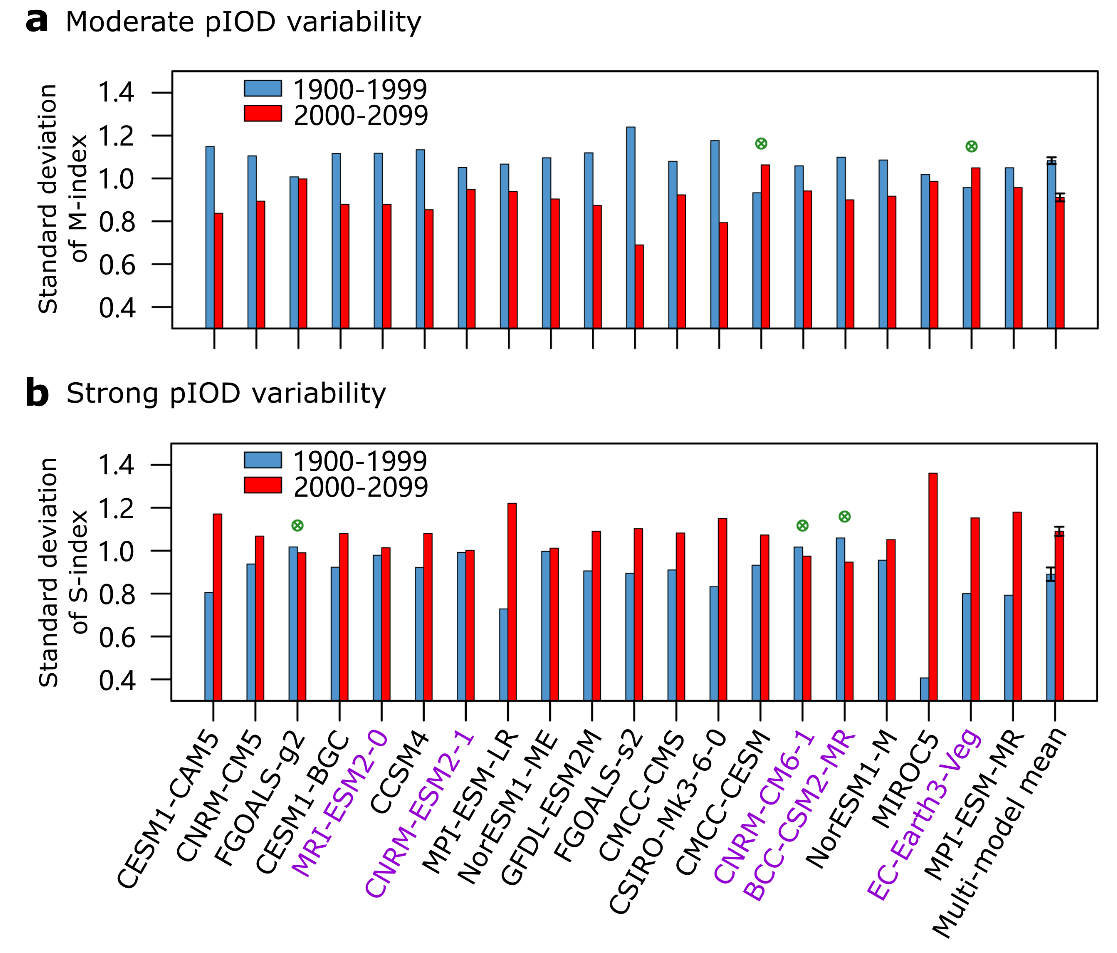More Climate Extreme Events Related to Indian Ocean Dipole under Global Warming
Date:2020-12-02
During the autumn and winter of 2019, Australia has experienced devastating bushfire seasons, known as the "black summer". At least 30 people were killed, 170,000 km2 of land was burned, and 3,000 buildings were damaged. These are related to a climate system known as the positive Indian ocean dipole (pIOD).
The IOD is conventionally described using the Dipole Mode Index (DMI) which measures two poles located in the western and eastern Indian Ocean. A pIOD event is associated with warm sea surface temperature (SST) anomalies in the equatorial western Indian Ocean (the western pole) and cold SST anomalies occur in the east (the eastern pole). During pIOD events, these cold SST anomalies in the east reduce atmospheric moisture and lead to drier than normal conditions in south-eastern Australia. In contrast, the warm SST anomalies in the western Indian Ocean are associated with increased rainfall in East Africa.
Understanding how the IOD will respond to a warmer climate is a question of utmost importance, made more difficult because models disagree on how pIOD SST may respond when using the conventional DMI.
Using the DMI assumes all models have similar pIOD patterns. To accurately capture pIOD diversity in models, two separate indices should be used, an S-index to represent strong events, and an M-index which describes moderate pIODs. Strong pIOD events are dominated by cooling in the eastern equatorial Indian Ocean while moderate events by broadscale warming in the western Indian Ocean.
Based on the new indices and CMIP5/6 models, a recent research published in Nature Climate Change shows that there is an opposite response between moderate and strong pIOD events. Eighteen out of the 20 models simulate a decrease in M-index (moderate pIOD) variability and 17 out of 20 models show an increase in S-index (strong pIOD) variability.
"This opposite response occurs due to mean state changes over the tropical Indian Ocean. Faster warming in the western than the eastern Indian Ocean is supported by a southeasterly wind trend. While the lower troposphere warms faster than the surface, increasing atmospheric stability. Ekman pumping is the main forcing for warm SST anomalies over the tropical western Indian Ocean. This process weakens in the future climate and leads to decreased M-index variability. For strong pIOD events, the faster mean warming in the west and northwest tropical Indian Ocean is favourable for anomalous atmospheric convection. This in turn facilitates anomalous easterly winds along the equator and enhances equatorial nonlinear zonal and vertical advection, and these processes are favourable for cold SST anomalies", said one of the authors, Dr. YANG Kai with the Institute of Atmospheric Physics at the Chinese Academy of Sciences.
Prof. HUANG Gang, another author of the paper, emphasized that "although there is a decrease in moderate pIOD events, extreme events similar to major floods and drought in 1997 and 2019 are expected to occur more frequently in a warmer climate".

Fig. 1 Projected opposite response of moderate and strong pIOD. a, A total of 18 out of the 20 selected models (90%) generate a reduction in moderate pIOD variability depicted by the M-index from the present-day (1900–1999, blue bars) to future (2000–2099, red bars) climate, with exception of two models generating an increase indicated by green circles. b, A total of 17 out of the 20 models (85%) simulate an increase in variability of strong pIOD described by the S-index from the present-day (1900–1999, blue bars) to future (2000–2099, red bars) climate.
Reference:
Cai, W. et al. (2020) Opposite response of strong and moderate positive Indian Ocean Dipole to global warming, Nature Climate Change, doi:10.1038/s41558-020-00943-1. https://www.nature.com/articles/s41558-020-00943-1.
Media contact: Ms. LIN Zheng, jennylin@mail.iap.ac.cn
